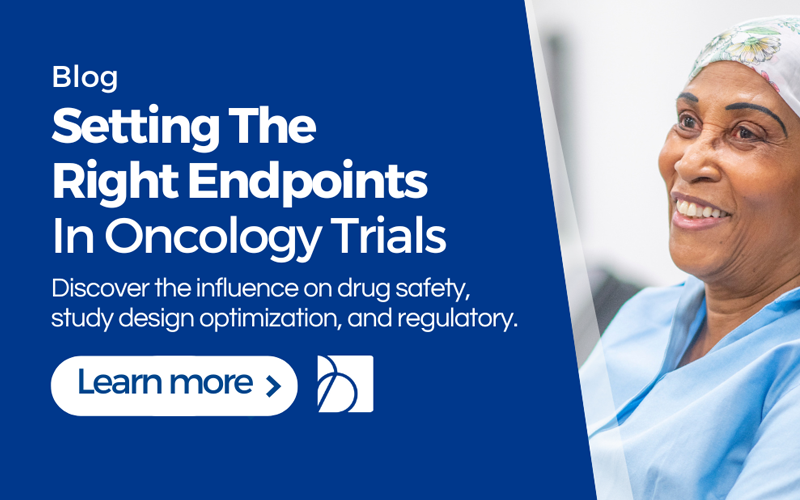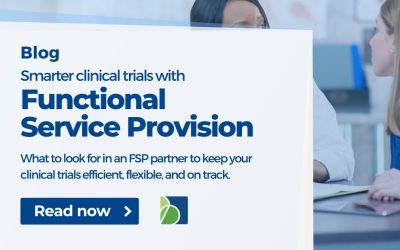In early-phase oncology clinical trials, the importance selecting the appropriate clinical endpoints cannot be overstated. These endpoints not only delineate the study’s outcomes but also critically influence the subsequent phases of drug development and the overarching decision-making process. Generally, endpoints in these trials can be bifurcated into two predominant categories: efficacy endpoints and safety endpoints
Why is it important to set the right clinical endpoints in Oncology?
The selection of appropriate endpoints is not merely a procedural step but a cornerstone that can shape the trajectory of the entire drug development process. These endpoints, when meticulously chosen, can provide a robust framework for assessing the drug’s potential benefits and risks, optimizing the study’s design, and meeting the stringent criteria set by regulatory bodies.
Assessment of Safety and Efficacy
It’s paramount that the study is structured to provide a comprehensive evaluation of the treatment’s safety and efficacy. Inaccurate or ill-defined endpoints could jeopardize the reliability and validity of the study’s findings.
Optimization of Study Design
Precise endpoint selection can significantly enhance the study design. This encompasses informed decisions regarding patient selection, dosing regimens, and sample size determination. Furthermore, it ensures that the study is adequately powered, thereby optimizing both its efficiency and cost-effectiveness.
Guidance for Regulatory Bodies
Regulatory entities, including but not limited to the FDA and EMA, heavily rely on the endpoints delineated in early-phase trials. These endpoints serve as foundational metrics for these agencies to evaluate the drug’s safety and efficacy, which subsequently influences their approval or rejection decisions.
Two primary types of endpoints stand out due to their significance: Efficacy Endpoints and Safety Endpoints.
Efficacy Endpoints
These are pivotal in assessing the clinical benefit of the investigational treatment. Within oncology trials, efficacy endpoints commonly encompass metrics such as the overall response rate (ORR), progression-free survival (PFS), and overall survival (OS). These metrics serve as robust indicators of the treatment’s potential in reducing or stabilizing tumors and, crucially, in enhancing patient survival.
Safety Endpoints
These are integral in evaluating the safety and tolerability profile of the treatment under investigation. Typically, this category includes adverse events (AEs) and serious adverse events (SAEs). The meticulous collection and analysis of these events are paramount to Wht ascertain the drug’s safety profile.
Challenges in Endpoint Selection In Oncology
The process of endpoint selection, while pivotal, is complex. Some of the prevalent challenges include:
- Relevance of Endpoints: The necessity to select endpoints that genuinely mirror the clinical benefit of the treatment under investigation. This task is further complicated by the diverse opinions of stakeholders regarding what constitutes a meaningful endpoint.
- Balancing Efficacy & Safety: Achieving a harmonious balance between efficacy and safety endpoints is intricate. The challenge lies in selecting endpoints that robustly represent the treatment’s clinical benefits while concurrently ensuring the paramountcy of patient safety.
- Patient Population Determination: The identification of an appropriate patient population is crucial to ensure the relevance of study endpoints. This task is rendered challenging due to the inherent variations in patients’ disease characteristics and their prior treatment histories.
- Efficiency in Study Design: Given the often limited patient pool and resources in early-phase trials, it’s essential to design the study with utmost efficiency, ensuring meaningful results are derived in a timely fashion.
- Navigating Regulatory Mandates: Regulatory stipulations can vary considerably across regions. Ensuring adherence to these diverse requirements is essential for global approval.
Strategies for Endpoint Determination in Clinical Trials
Endpoint selection in clinical trials, particularly in early-phase oncology studies, is of paramount importance. The chosen endpoints can significantly influence the study’s outcomes, the subsequent phases of drug development, and the overarching decision-making process. Given this criticality, how can researchers navigate this complex terrain and ensure they’re on the right path? Here’s a more detailed exploration of the structured approach:
Objective Definition
Before diving into endpoint selection, it’s essential to have a clear understanding of what the study aims to achieve.
Begin by outlining the primary and secondary objectives of the trial. Are you looking to assess the drug’s efficacy, its safety profile, or both? This clarity will serve as a compass, guiding the subsequent steps of endpoint selection.
Disease and Treatment Analysis
Understanding the intricacies of the disease under study and the nuances of available treatments can significantly influence endpoint selection.
Delve deep into the current literature, review existing data on the disease’s progression, symptoms, and impact. Additionally, analyze the mechanisms and outcomes of existing treatments. This will provide a backdrop against which the investigational treatment can be assessed.
Stakeholder Engagement
Different stakeholders bring varied perspectives, all of which can enrich the endpoint selection process.
Organize consultations or focus group discussions with physicians who treat the disease, patient advocates who can voice patient concerns and priorities, and representatives from regulatory authorities who can provide insights into regulatory expectations. Their collective feedback can ensure that the selected endpoints are comprehensive, relevant, and aligned with broader expectations.
Historical Data Review
Previous trials, especially those with objectives mirroring the current study, can serve as valuable reference points.
Review data from past trials, focusing on the endpoints they employed, the challenges they encountered, and the results they achieved. This retrospective analysis can offer insights into what worked, what didn’t, and why.
Holistic View of Efficacy and Safety
A drug’s efficacy and safety profile are both crucial, and endpoints should reflect this dual importance.
While efficacy endpoints might focus on the drug’s therapeutic impact, safety endpoints should capture potential side effects, adverse events, and other risks. Ensure that the chosen endpoints provide a balanced view of both these aspects.
Adequate Study Powering
A study that’s inadequately powered might fail to detect significant effects, leading to potentially erroneous conclusions.
Collaborate with biostatisticians to determine the appropriate sample size for the study, ensuring it has sufficient power to detect differences or changes based on the selected endpoints.
Endpoint Flexibility
Clinical trials are dynamic, and new data or insights might emerge as the study progresses.
While it’s essential to start with well-defined endpoints, it’s equally important to build in mechanisms that allow for adjustments based on interim analyses or new external evidence. This flexibility can ensure that the study remains relevant and robust throughout its duration.
In conclusion, the process of endpoint determination, while intricate, can be navigated successfully with a systematic, informed approach. By integrating a blend of foundational clarity, stakeholder insights, historical context, and adaptability, researchers can set the stage for a meaningful and impactful clinical trial.













